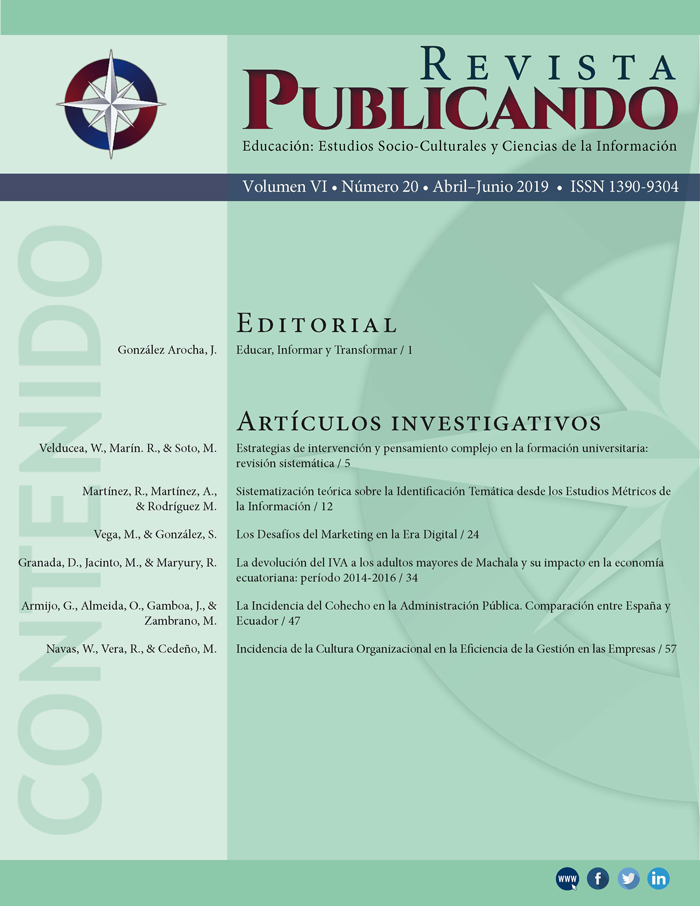Abstract
The present article has a qualitative approach, where the main challenges that the Marketing areas have in the era of disruptive technologies are presented. At the same time, it examines the opportunities offered by the same technologies to deal with the capture, management and treatment of large volumes of information scattered in different sources, whose heterogeneous, unstructured data concentrate the basic elements to develop invaluable information to the departments. of Marketing, given that there would be market trends, attributes and ideal characteristics to develop products and services tailored to consumers.References
Alcaide, J. C. (2015). Fidelización de clientes. Madrid: ESIC Editorial.
American Marketing Association. (28 de mayo de 2013). AMA Dictionary. Recuperado de AMA Dictionary: https://www.ama.org/resources/pages/dictionary.aspx?dLetter=M
Awareness Inc. (2012). The State of Social Media Marketing Industry Report 2012: new ROI framework. Meet Social ROMO and Social ROMI. Recuperado de http://www.jdhuez.com/wp-content/uploads/2013/04/New_ROI_Framework.pdf
Barba , J. (10 de febrero de 2014). 12 tecnologías disruptivas que están cambiando el mundo. Tijuana, Baja California, Mexico. Recuperado de http://www.sandiegored.com/es/noticias/77502/12-tecnologias-disruptivas-que-estan-cambiando-el-mundo
Ferrell, O. C., & Hartline, M. D. (2012). Estrategia de Marketing. Mexico: Cengage Learning Editores.
Galimary, A. (1 de julio de 2014). La creación de valor en las empresas a través del Big Data. Barcelona: Universidad de Barcelona.
García, J. (2014). Marketing hasta la última definición de la AMA (American Marketing Association). Revista de la asociación española de investigación de la comunicación, 1(2), 124-132.
Instituto Tecnológico de Massachusetts. (1 de mayo de 2014). Las 10 tecnologías más disruptivas de 2014, según el MIT. Madrid, España. Recuperado de http://www.elmundo.es/economia/2014/05/01/53626d5ee2704e897e8b4578.html
Joyanes, A. L. (2014). Big Data: análisis de grandes volumenes de datos en organizaciones. Barcelona: Marcombo.
Joyanes, A. L. (2013). Computación en la Nube: estrategias de cloud computing en las empresas. Barcelona: Marcombo.
Kostoff, R. N., Boylan, R., & Simons, G. R. (2004). Disruptive technology roadmaps. Technological Forecasting and Social Change, 71(1-2), 141-159.
Kotler, P., & Armstrong, G. (2014). Principles of Marketing (16 ed.). Australia: Pearson.
McKinsey Global Institute. (1 de mayo de 2011). Big Data: The next frontier for innovation "marketeras" de la mano de 9 profesionales en Arena Tech & Trends. Recuperado de https://www.mckinsey.com/business-functions/digital-mckinsey/our-insights/big-data-the-next-frontier-for-innovation
Ortiz, M., Joyanes, L., & Giraldo, L. (2016). Los desafíos del marketing en la era del Big Data. e. Ciencias de la Información, 6(1), 6.
Plummer, D. C., Fiering, L., Dulaney, K., McGuire, M., Da Rold, C., Sarner, A., ”…Marian, K. (4 de octubre de 2014). Top 10 Strategic Predictions for 2015 and Beyond: Digital Business Is Driving 'Big Change'. Recuperado de Gartner: https://www.gartner.com/doc/2864817
Sainz de Vicula Ancin, J. M. (2016). El Plan de Marketing Digital en la Práctica. Madrid: ESIC EDITORIAL.
Sainz, d. J. (2015). El plan de marketing en la práctica. Madrid: ESIC Editorial.
Schmarzo, B. (2014). Big Data: el poder de los datos. Madrid: Ediciones Anaya Multimedia.
Serrano, M. (2012). Qué es el social media ROI y Cómo medirlo: guía paso a paso para calcular el retorno de tus campañas de Social Media. Recuperado de http://socialancer.com/wp-content/uploads/2012/12/Guia-de-Social-Media-ROI.pdf
Solana, A., & Roca, G. (2015). Big Data para directivos: guía rápida y ejemplos prácticos. Barcelona: Ediciones Urano.
Vergoñós Pascual, M. (1 de julio de 2015). ¿Qué es la tecnología disruptiva? Recuperado de La Vanguardia: http://www.lavanguardia.com/economia/management/20150701/54433059777/tecnologia-disruptiva-innovacion.html
Villaseca Morales, D. (2014). Innovación y marketing de servicios en la era digital. Madrid: ESIC.
You are free to:
Share — copy and redistribute the material in any medium or format.
Adapt — remix, transform, and build upon the material.
The licensor cannot revoke these freedoms as long as you follow the license terms.
Under the following terms:
Attribution — You must give appropriate credit, provide a link to the license, and indicate if changes were made. You may do so in any reasonable manner, but not in any way that suggests the licensor endorses you or your use.
NonCommercial — You may not use the material for commercial purposes.
ShareAlike — If you remix, transform, or build upon the material, you must distribute your contributions under the same license as the original.
No additional restrictions — You may not apply legal terms or technological measures that legally restrict others from doing anything the license permits.
